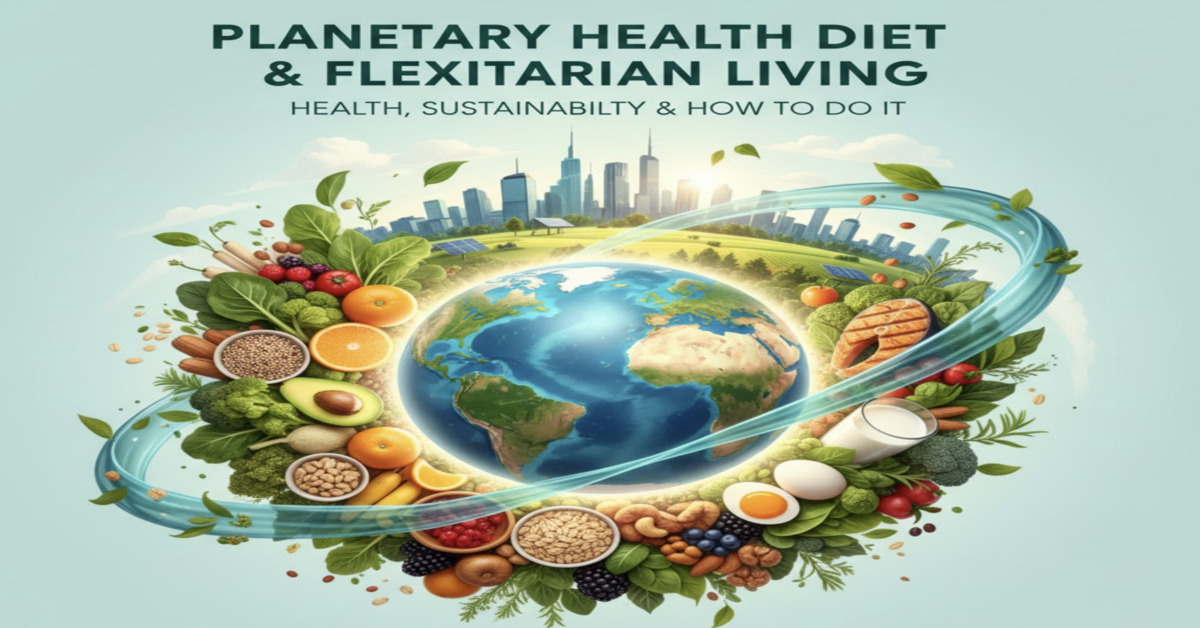1. Introduction: What Is the Planetary Health Diet?
The Planetary Health Diet (PHD), introduced by the EAT-Lancet Commission, is a science-based eating plan designed to support human health while ensuring environmental sustainability. In the U.S., with high rates of obesity, diabetes, and cardiovascular diseases, adopting a mostly plant-based but flexible diet can help combat chronic illnesses while reducing environmental impact.
Flexitarian living, a flexible plant-focused approach, aligns perfectly with the PHD by promoting nutrient-rich foods, limiting red and processed meats, and incorporating sustainable practices in everyday life.

2. Why the Planetary Health Diet Matters in 2025
Americans consume, on average, far too many animal-based foods and processed products, contributing to obesity, diabetes, and heart disease. Simultaneously, food production accounts for 30% of global greenhouse gas emissions.
Adopting the Planetary Health Diet in the U.S. context offers dual benefits:
- Personal health: Lower risk of chronic disease, improved metabolic health, and longevity.
- Environmental health: Reduced carbon footprint, water usage, and deforestation impact.
Statistic: A 2024 Harvard study found that Americans adhering to plant-forward diets had a 25–30% reduced risk of cardiovascular disease.
3. Flexitarian Living: The Practical Pathway
Flexitarianism emphasizes plant-based foods while allowing occasional animal products, making it a practical way to transition toward the Planetary Health Diet without strict restrictions.
Key Principles for U.S. Residents:
- Eat mostly plants (vegetables, fruits, legumes, whole grains, nuts).
- Limit red meat and processed foods.
- Include lean proteins like poultry, fish, and eggs moderately.
- Focus on locally sourced, seasonal produce where possible.
4. Core Food Groups and Portion Guidelines
| Food Group | Recommended Daily Amount | Example Foods |
|---|---|---|
| Vegetables | 10 oz (300g) | Leafy greens, carrots, broccoli |
| Fruits | 8 oz (250g) | Berries, apples, bananas |
| Whole grains | 7 oz (200–250g) | Oats, quinoa, brown rice |
| Plant-based protein | 3–4 oz (100–120g) | Lentils, beans, tofu |
| Animal protein (optional) | ≤ 3 oz (90g) | Eggs, fish, lean poultry |
| Healthy fats | 1–2 tbsp | Olive oil, nuts, seeds |
| Added sugars | <1 oz (30g) | Minimal intake only |
5. Health Benefits: From Metabolic Balance to Longevity
1. Improved Metabolic Health: Plant-forward diets reduce insulin resistance and support stable blood sugar.
2. Cardiovascular Protection: High fiber, antioxidants, and unsaturated fats lower cholesterol and blood pressure.
3. Weight Management: Plant-rich diets promote satiety and reduce calorie density.
4. Gut Microbiome Support: Legumes, vegetables, and whole grains feed beneficial gut bacteria.
5. Longevity: Diets aligned with the PHD correlate with longer life expectancy and lower chronic disease incidence.
Statistic: U.S. study (2023) showed flexitarian participants had a 28% lower risk of metabolic syndrome.
6. Environmental Impact: Eating for the Planet
The PHD reduces environmental strain by emphasizing low-impact foods:
- Legumes and grains require less water and emit fewer greenhouse gases.
- Reducing red meat lowers carbon emissions significantly.
- Choosing seasonal produce supports local agriculture and reduces transportation energy.
Fact: Halving U.S. red meat consumption could reduce personal food-related emissions by up to 40%.
7. Getting Started: Practical Steps for U.S. Beginners
- Start slow: Replace one meal daily with plant-based options.
- Batch prep: Cook legumes, grains, and vegetables ahead of time.
- Plate method: Fill half your plate with vegetables and fruits.
- Swap smartly: Replace red meat with beans, lentils, tofu, or fish.
- Use healthy fats: Olive oil, avocado, and nuts as primary fat sources.
- Grocery planning: Focus shopping lists on plant-forward, nutrient-dense foods.
8. Common Challenges and How to Overcome Them
| Challenge | Solution |
|---|---|
| Missing flavor in plant meals | Use spices, herbs, and umami-rich ingredients like mushrooms or nutritional yeast |
| Social dining pressures | Suggest plant-based options at restaurants or potlucks |
| Ensuring adequate protein | Include legumes, tofu, tempeh, or moderate lean animal proteins |
| Nutrient gaps (B12, Omega-3) | Use fortified foods or supplements as recommended |
9. Expert Opinions and Scientific Backing
“Even partial adoption of the Planetary Health Diet can significantly reduce chronic disease risk and improve sustainability outcomes.”
— Dr. Walter Willett, Harvard University
“Flexitarian approaches offer Americans a practical, realistic method for better health and lower environmental impact.”
— Dr. Tim Lang, EAT-Lancet Commission
Statistic: Global modeling studies suggest widespread PHD adoption could prevent up to 11 million premature deaths annually.
10. Checklist for Sustainable Eating in 2025
✅ Prioritize plant-based meals
✅ Minimize red and processed meats
✅ Eat 30+ different plant foods weekly
✅ Choose seasonal, local produce
✅ Avoid food waste
✅ Maintain hydration with water and herbal teas
11. Frequently Asked Questions (FAQ)
Q1: Is the diet vegetarian or vegan?
A: No — it’s flexible. Small portions of animal foods are allowed.
Q2: Can it support athletes or active individuals?
A: Yes, when protein intake is sufficient from plant or lean animal sources.
Q3: Are supplements necessary?
A: Consider B12, Vitamin D, and Omega-3 if consuming minimal animal foods.
12. Authoritative Resources
- Harvard T.H. Chan School of Public Health – Planetary Health Diet
- EAT-Lancet Commission Report
- World Resources Institute – Sustainable Eating
13. Other Interesting Articles on Fitoast
14. Conclusion & Call-to-Action
The Planetary Health Diet and flexitarian living offer a sustainable, practical approach to improving health, longevity, and environmental impact in the U.S. Adopting this diet doesn’t require perfection — even small shifts toward plant-based meals make a significant difference.
Next Steps: Start incorporating more vegetables, legumes, and whole grains into daily meals, reduce red meat gradually, and focus on sustainable, nutrient-dense foods. Track your progress and experiment with recipes — your health and the planet will thank you.

